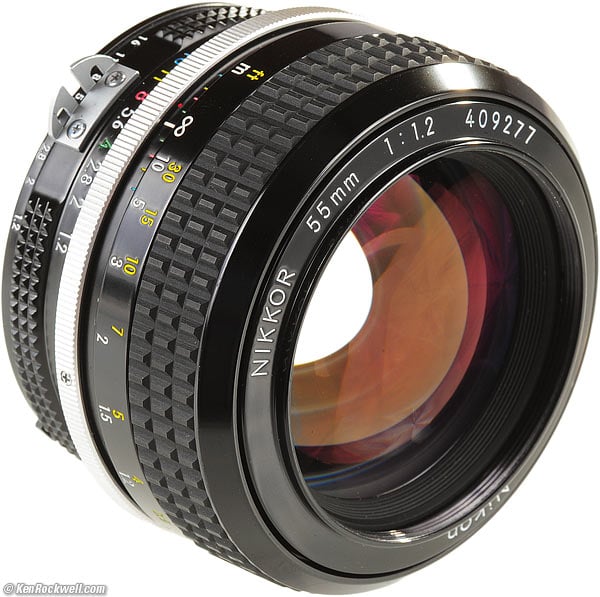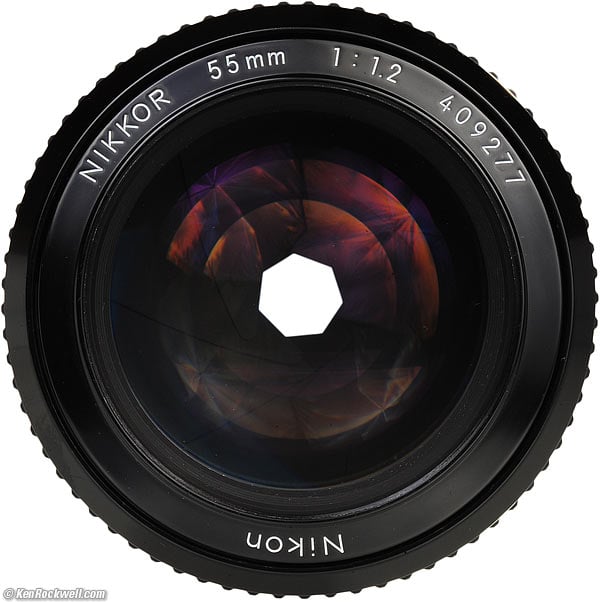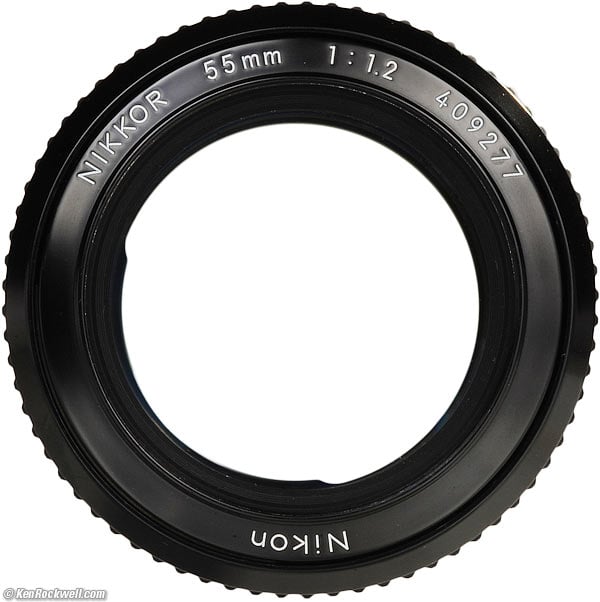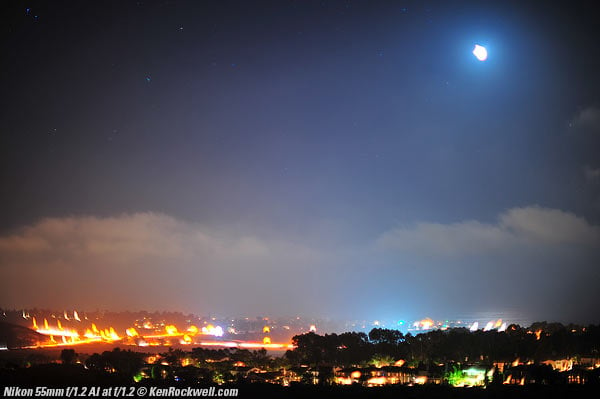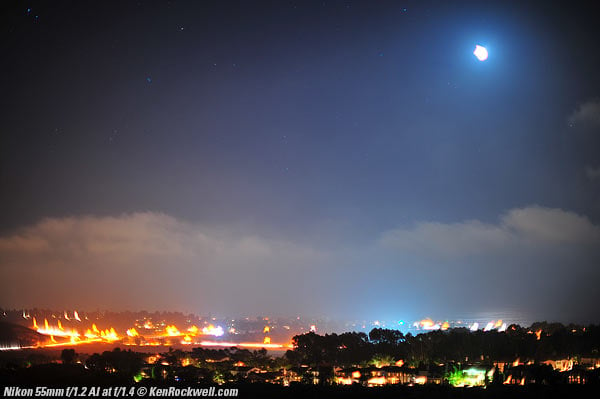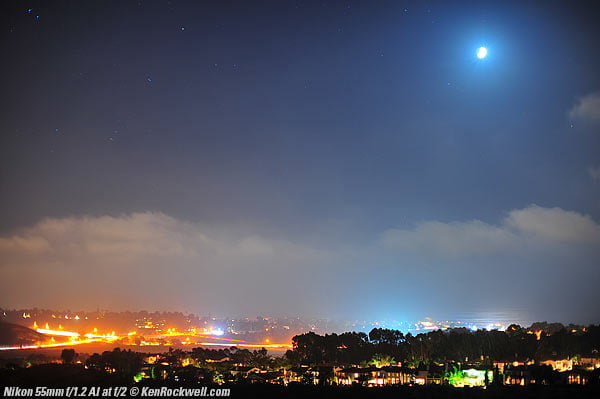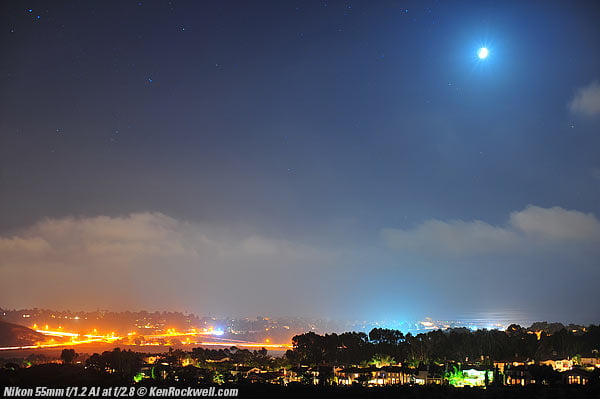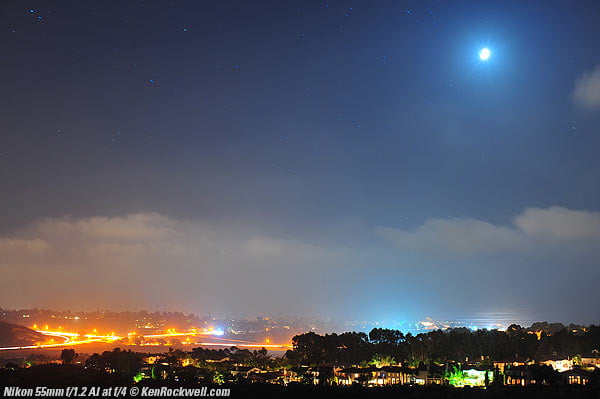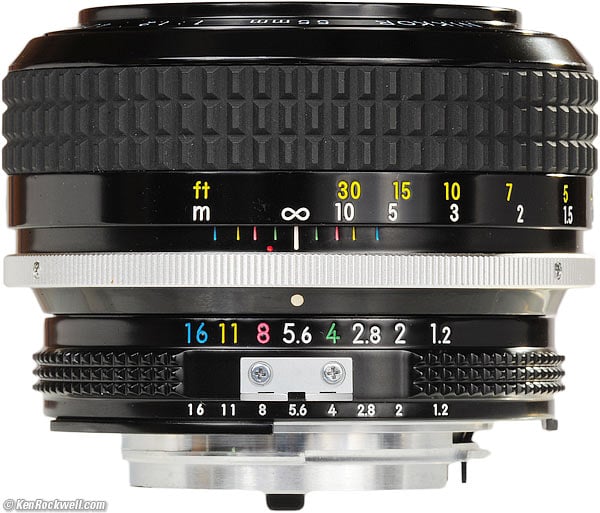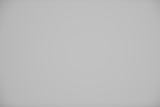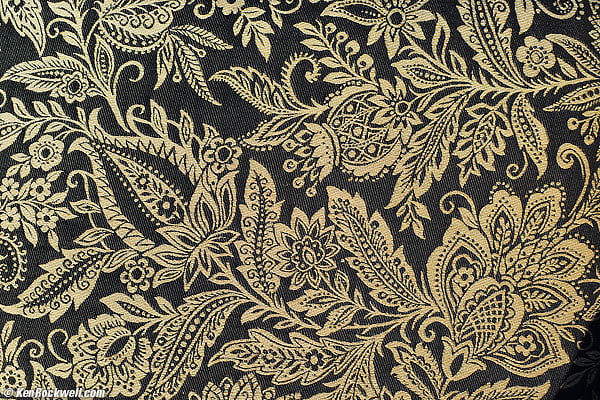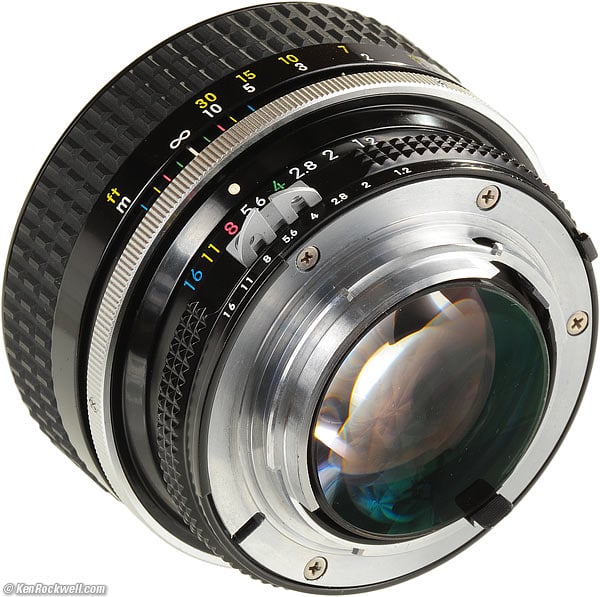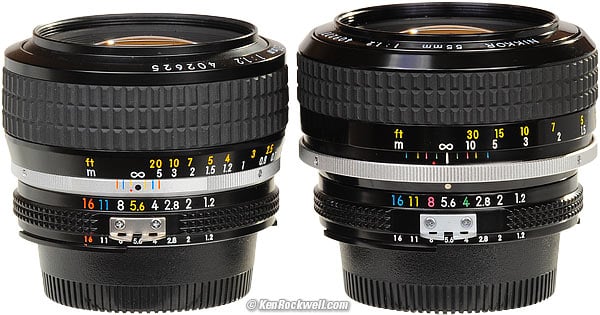Home Donate New Search Gallery Reviews How-To Books Links Workshops About Contact
Nikon 55mm f/1.2
F and AI NIKKOR (1965-1978)
© 2012 KenRockwell.com. All rights reserved.
Intro Specifications Performance Compared Recommendations
Nikon 55mm f/1.2 AI (FX, DX and 35mm coverage, 52mm filters, 14.5 oz./410g, 1.63'/0.5m close focus, about $325 used). enlarge. This free website's biggest source of support is when you use any of these links, especially this direct link to the Nikon 55/1.2 at eBay (see How to Win at eBay), or at Adorama, when you get anything, regardless of the country in which you live. Thanks! Ken.
December 2012 Nikon Reviews Nikon Lenses All Reviews
50mm f/1.2 (1978-today)
58mm f/1.2 Noct-NIKKOR (1977-1997)
Sample Image File
Palm. D800E, f/8 at 1/60 hand-held at Auto ISO 110. Original 36MP file.
Introduction top
Intro Specifications Performance Compared Recommendations
Compatibility History & Production
|
Adorama pays top dollar for your used gear. I use these stores. I can't vouch for ads below.
|
This Nikon 55mm f/1.2 was Nikon's first ultra-speed f/1.2 lens. Nikon has never made a faster SLR lens, it's merely made them in slightly different focal lengths of 50mm and 58mm.
Nikon replaced this lens with today's slightly smaller 50mm f/1.2 AI-s in the spring of 1978. It performs about the same.
Nikon also made an aspherical 58mm f/1.2 Noct-NIKKOR from 1977-1997, which is completely unrelated in performance. Nikon's first 58mm f/1.4 (1959-1962) has no relation to the 58mm or this 55mm f/1.2 either.
This 55mm f/1.2 lens first shipped as an F-mount lens, and was updated to AI (Automatic Indexing) in 1977.
This 55mm f/1.2 lens has low contrast and loads of spherical aberration and coma at f/1.2, and cleans up nicely as stopped down. If you're stopping it down, you may as well use any 50mm f/1.4 instead, and if you want high contrast at f/1.2, use the 58mm f/1.2 Noct-NIKKOR.
The reason this lens exists was to give little men bragging rights decades ago when little men bragged about the speed of their lens as opposed to how many pixels their camera had.
Today, the reason for this lens is if you want a soft-contrast effect with very little depth-of-field at f/1.2. Otherwise, at smaller apertures other lenses do what this lens does, but better, for less money.
The earlier F-mount versions of this lens will not work on most cameras today unless it has been updated to AI, as most have been today.
Presuming it's been updated to, or originally shipped as an AI lens, this manual-focus Nikon 55mm f/1.2 works great with most Nikon cameras, 35mm and digital.
It works flawlessly with every manual focus Nikon ever made, from the original Nikon F of 1959 through the FM3a and today's FM-10.
On the D4, D800, D800E, D600, D3X, D3s, D3, D7000, D700, D300, D200, D2 and F6, use the "Non-CPU Lens Data" menu option to set 55mm and f/1.2 to get full color matrix metering, EXIF data and finder read-out of set aperture. It works great in aperture-preferred as well as manual modes on these cameras.
It works perfectly on every professional 35mm camera (F, F2, F3, F4, F5, F6), and adds Matrix metering on the FA, F4 and F6.
The meters of cheaper digital (D90, D5100 and below) and cheaper film cameras (N80 and below) will not couple (or work at all) with this lens, so you'll be on your own guessing exposure using the rear LCD or an external meter, or get a tiny Gossen Digisix meter and hotshoe adapter, or the free Pocket Light Meter app to meter manually.
See Nikon Lens Compatibility for full details on your camera. Read down the "AI, AI-s" column for this lens if it shipped as AI, or the "AI Converted" column if it was updated to AI from an earlier version. If it's still in its original F-mount form, then read the Pre-AI column, and it won't mount on most cameras made since 1977.
History & Production intro top
1965-1972 (F mount)
The all-new NIKKOR-S 55mm f/1.2 in F mount had all-metal fluted focus and aperture rings.
It focuses to 0.6 meters (2 feet).
Nikon made about 56,000 of these.
1972-1974 ("C," multicoated)
The NIKKOR-S•C 55mm f/1.2 was the same as the first 1965 version, adding multicoating, thus the "•C" designation.
Multicoating is a real, but subtle, improvement, offering higher contrast and more uniform color rendition to match other NIKKOR lenses.
Nikon made about 50,000 of these.
1974-1977 ("K")
Nikon replaced the all-metal fluted focus ring with a less expensive plain one, covered with rubber nubs instead of flutes. Its aperture ring now has three rows of pyramidal nubs instead of linear flutes.
This version now focuses as close as 0.5 meters (1.6 feet).
This lens is simply marked NIKKOR. Hobbyists call this a "K" style lens.
Nikon made about 60,000 of these.
1977-1978 (AI)
Nikon updated the previous version to AI, Automatic Indexing.
Nikon made about 40,000 of these.
Total Production
Nikon made about 210,000 of these overall.
Is yours a native AI lens?
You can tell if your lens is a native AI, or if it is an earlier version updated to AI, from its serial number. Native AI 55/1.2 lenses have six-digit serial numbers beginning with 4, like the lens seen here.
Used Prices
Used prices have been unchanged since 2008: $325 used.
Nikon 55mm f/1.2 AI. enlarge.
Specifications top
Intro Specifications Performance Compared Recommendations
Name
Nikon calls this various names, depending on the year. This one is a Nikon NIKKOR 55mm f/1.2 AI.
Optics top
7 elements in 5 groups.
Older versions are single-coated, and newer versions made since 1972 like the one shown here are multicoated.
Diaphragm top
Nikon 55mm f/1.2 AI at f/5.6. enlarge.
Nikon 55mm f/1.2 AI at f/1.2. enlarge.
7 straight blades.
Stops down to f/16.
Aperture Ring top
Yes.
Metal.
Full-stop clicks.
Close Focus top
1965-1974 (fluted metal focus ring)
2 feet.
0.6 meters.
190º focus-ring rotation.
1974-1978 (rubberized focus ring)
1.6 feet.
0.5 meters.
230º focus-ring rotation.
Maximum Reproduction Ratio top
1965-1974 (fluted metal focus ring)
1:9.0.
1974-1978 (rubberized focus ring)
1:7.3.
Angle of View top
43° diagonal on FX and 35mm.
28.5° on small-format DX.
Focal Length top
55mm.
On a small-format DX (or Canon EOS-M or Sony NEX) camera, this lens makes pictures that see an angle-of-view similar to what an 85mm lens would see on a full-frame camera.
On Nikon One cameras, this lens makes pictures that see an angle-of-view similar to what a 150mm lens would see on a full-frame camera.
Hard Infinity Focus Stop? top
Yes.
This is great for astronomy; just turn to the stop and you have fixed laboratory-perfect focus all night.
Focus Scale top
Yes.
Depth-of-Field Scale top
Yes, colored lines corresponding to the colored f/stops on the aperture ring.
Infra-Red Focus Index top
Yes: red dot near f/4 in depth-of-field scale.
Filter Thread top
52mm, metal.
Does not rotate.
Size top
1965-1974 (F mount and "C" versions, fluted metal focus ring)
Nikon specifies 49.5mm (1.95") extension from flange (58.5mm/2.30" overall) by 73.5mm (2.89") diameter.
1974-1977 ("K," rubber focus ring)
Nikon specifies 49.5mm (1.95") extension from flange (58.5mm/2.30" overall) by 72mm (2.83") diameter.
1977-1978 (AI)
Nikon specifies 49.5mm (1.95") extension from flange (61mm/2.40" overall) by 72mm (2.83") diameter.
Weight top
1965-1974 (F mount and "C" versions, fluted metal focus ring)
Nikon specifies 14.8 oz. (420g).
1974-1978 ("K" and AI versions, rubber focus ring)
14.470 oz. (410.15g), measured.
Nikon specifies 14.4 oz. (410g).
Hood top
1965-1974 (F mount and "C" versions, fluted metal focus ring)
HN-6 metal screw-in.
HS-3 snap-in metal.
1974-1978 ("K" and AI versions, rubber focus ring)
HS-7 snap-in metal.
HR-2 screw-in rubber.
Case top
1965-1974 (F mount and "C" versions, fluted metal focus ring)
# 51 or CP-1 plastic bubble.
1974-1978 ("K" and AI versions, rubber focus ring)
CL-34A, Corinthian leather.
# 61 or CP-1 plastic bubble.
Quality top
Made in Japan.
Teleconverters top
TC-200/201 and TC-14A.
Nikon warns of potential "uneven exposure" at high shutter speeds or apertures smaller than f/11, but after reading these warnings for over 25 years I still have no idea what they're talking about.
Gotcha: teleconverters only "see" through about an f/1.8 aperture maximum, so you're still at about T4 with the 2x converter, and your TTL meter will be quite confused except at maximum aperture.
I'd skip teleconverters.
Performance top
Intro Specifications Performance Compared Recommendations
Overall Bokeh Color Coma Distortion Ergonomics
f/1.2 Light Acceptance Falloff Filters Focus
Focus Breathing Ghosts Color Fringes Macro
Mechanics Sharpness Spherochromatism Sunstars
Overall performance top
The 55mm f/1.2 is a typical NIKKOR manual-focus lens, very similar to the common 50mm f/1.4, except a fraction of a stop faster and significantly bigger and heavier.
This means it's sharp, but has low contrast wide-open, and gets much contrastier very quickly as stopped down. It has a lot of coma wide-open, which also quickly corrects itself as stopped down.
Bokeh performance top
Bokeh, the character of out-of-focus backgrounds, not simply how far out of focus they are, is poor at f/1.2, and neutral by f/2.
At f/1.2 the background is way out of focus, but highlight points of light tend to turn into donuts as opposed to smooth blurs.
I focused on a reference phase lattice at 3 meters (10 feet) with synthetic reference vegetation at 15 meters (50 feet).
Here are crops from the center of FX 24MP (D600) images at 33% magnification. In other words, each crop here is about 1/7 the width of the entire image. Printed full-image at this magnification, these would be about 20 x 13 " (51 x 34cm) prints, at least as seen on most 100 DPI computer monitors:
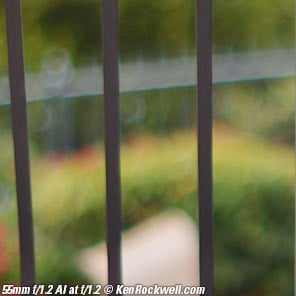 |
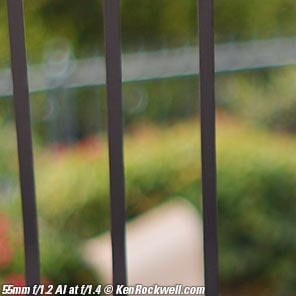 |
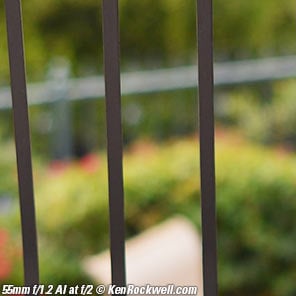 |
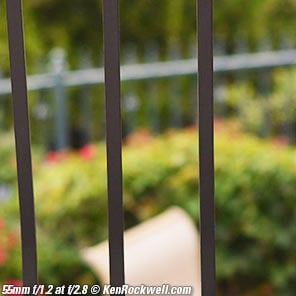 |
No, you won't see much difference between f/1.2 and f/1.4 because it's only a fraction of an f/stop. On my 30" monitor I can see it, but you won't see it on this web-size snippets above. Look carefully at the width of the gray out-of-focus diagonal line, and you'll see it's wider in the f/1.2 shot.
Compared to a 50mm lens, this 55mm lens has a 10% longer focal length, which means the same things at the same distance will have larger blur circles than with a 50mm lens.
Color Rendition performance top
The color rendition of this multicoated Nikon 55mm f/1.2 AI matches my other modern NIKKOR lenses.
The older single-coated versions are likely to have slightly different color rendition.
Coma performance top
As expected, this lens is loaded with coma. This is why Nikon invented the 58mm Noct-NIKKOR, which eliminates coma
Coma is weird smeared blobs that appear around bright points of light in the corners. They happen with fast and wide lenses at large apertures. Coma goes away as stopped down, and tends not to be seen in slower and tele lenses. Coma is an artifact of spherical aberration.
Full-Frame Samples
Crops from lower-left of the above full-frame shots (all: 12MP Nikon D3).
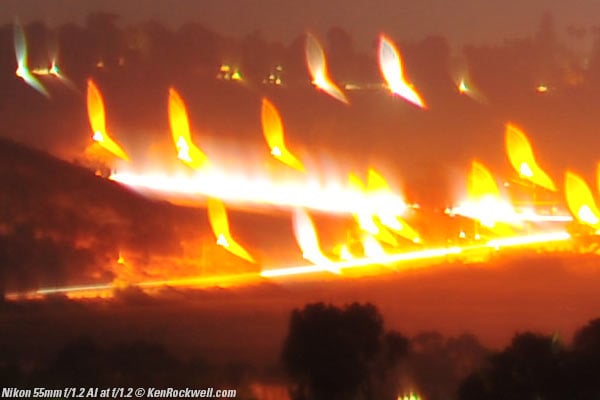
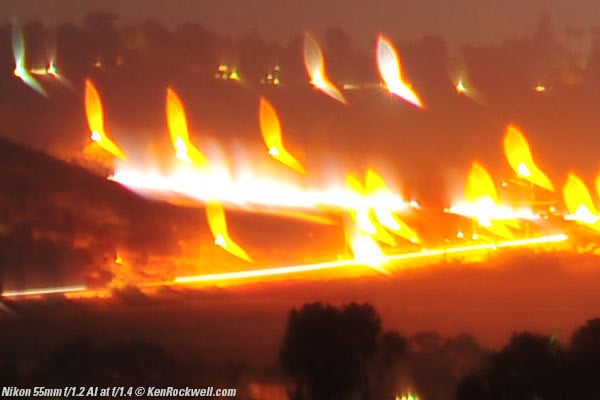
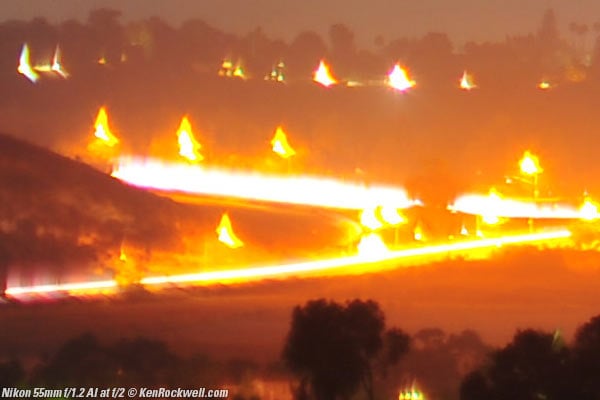
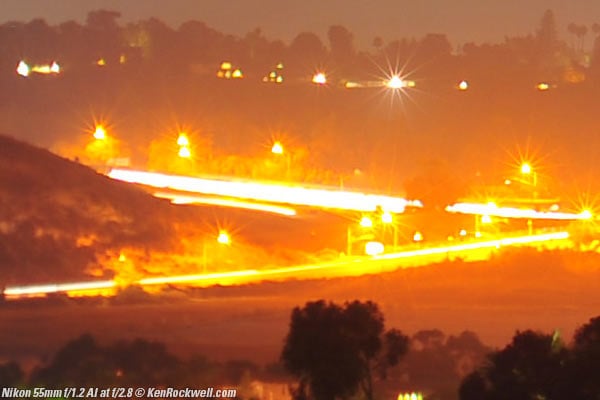

Distortion performance top
The Nikon 55mm f/1.2 has moderate barrel distortion. It's a bit more than any of the 50mm f/1.4 AI, AI-s, AF and AF-D lenses, and the same as the newest 50mm f/1.4 G lens.
It can be corrected completely by plugging these figures into Photoshop's lens distortion filter. These aren't facts or specifications, they are the results of my research that requires hours of photography and calculations on the resulting data.
FX and Film |
||
∞ |
+1.9 |
+1.1 |
30' (10m) |
+1.9 |
© 2012 KenRockwell.com. All rights reserved.
Ergonomics performance top
Nikon 55mm f/1.2. enlarge.
The Nikon 55mm f/1.2's ergonomics are as expected for Nikon manual-focus lenses.
The focus is more heavily damped than most NIKKORs; you'll want to use at least two fingers to focus.
Focus is very precise, with about 230º rotation required just to get to 0.5 meters. The f/1.4 AI-s lens is geared to focus much more quickly. If you're focusing with a loupe or with Live View zoomed in, you'll appreciate the precise focus, but if you're trying to focus on moving subjects, you'll prefer the newer 50mm f/1.2 AI-s instead, which focuses over the same range with half the rotation.
Aperture setting is as expected, just turn the ring. Real shooters can set it with their eyes closed; we count clicks.
f/1.2 Digital Sensor Acceptance performance top
There was an article on some amateur website some years back that claimed that the microlenses on DSLR sensors prevented them from seeing anything faster than about f/1.7, and that when lenses were set faster than that, that the cameras cheated and goosed-up the ISO secretly to pretend that the sensors really were catching all the light from ultraspeed lenses!
I knew some might be curious, here's proof that the sensor of my D800E is getting it all.
These are crops from the center of out-of-focus images at different apertures.
As you can see, opening the aperture to f/1.2 clearly shows that the sensor is responding just fine to the entire cone of light.
These are crops from about the middle one-seventh of the sensor in height and width:
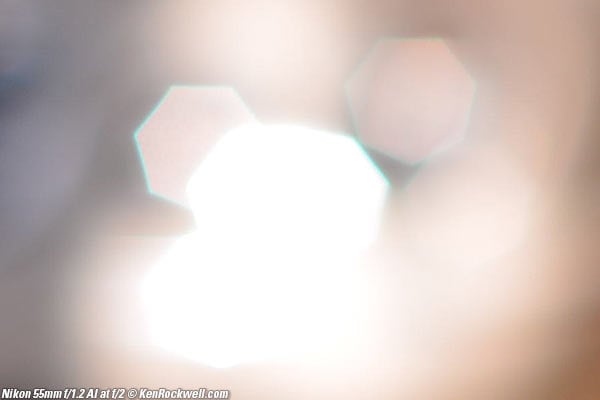
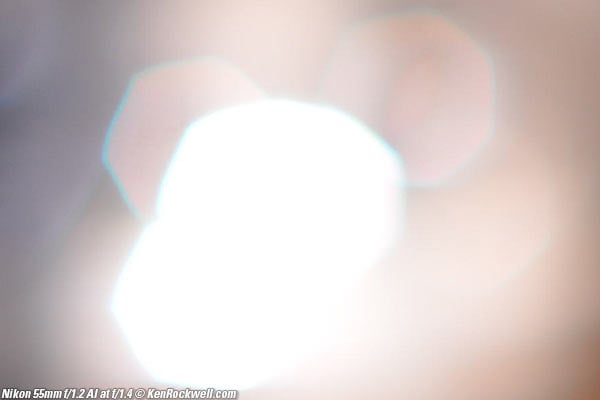
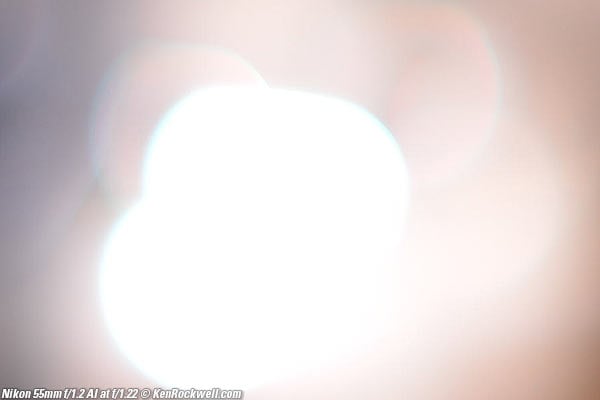
The larger blur circles at each aperture show us that the D800E is grabbing all the light from the entire f/1.2 cone of incoming light. There isn't that much increase at f/1.2 because there isn't that much of a difference in speed between f/1.2 and f/1.4, but you can see the absence of the 7-blade diaphragm at f/1.2 from the round blurs at f/1.2 versus heptagonal at f/1.4.
Falloff (darkened corners) performance top
Falloff on FX is visible at f/1.2 and f/1.4, and gone by f/2.
It won't be an issue at all on DX (see crop factor).
DSLRs as of 2012 are not able to correct this as they often can with autofocus lenses.
I've exaggerated this by shooting a gray field and placing these on a gray background:
Nikon 55mm f/1.2 falloff on FX and film at infinity, no correction.
© 2012 KenRockwell.com. All rights reserved.
|
Filters, Use with performance top
There is no problem with vignetting, even with thick filters.
Flare and Ghosts performance top
I never saw any flare or ghosts, even shooting into the sun.
I'm sure if I went out of my way I could find some, but I don't see any and need not bother with a hood.
Focus performance top
Manual focus is smooth and precise. It's more damped than most NIKKORs, and has no play.
Manual focus is flawless, both with a real camera like the Nikon F3, or with the three-way ( " > o < " ) manual focus indicators on newer cameras like the D4, D600, D800, D800E, D3X, D3s, D3, D700, F4, F5, F6 and most professional AF cameras.
If you have more than one AF sensor on an autofocus Nikon, you may use any sensor and the dot or dots in your finder will read from them.
Lesser digital cameras, like the D300s and down, usually have just one "OK" focus dot, which is not as precise as two arrows and a dot.
For the most precise focus at f/1.2, use Live View at the largest magnification, if you have it. If you do this, you can focus far more precisely and accurately than with any other method — if your subject isn't moving.
With my D800E, I got the best results when the electronic manual focus indicators read " > o." This will vary between different samples of lens and body.
With my D600, I got the best results when the electronic manual focus indicators read zero.
Focus Breathing performance top
Of interest mostly to cinematographers focusing back and forth between two subjects, the image from the Nikon 55mm f/1.2 AF-S gets larger as focused more closely.
The 55 1.2 is a traditional unit-focus lens.
Lateral Color Fringes performance top
There are no lateral color fringes on the D800E, D600 or D3, which would correct them if the lens had any. I haven't tried on other Nikon cameras and expect the same results.
Macro performance top
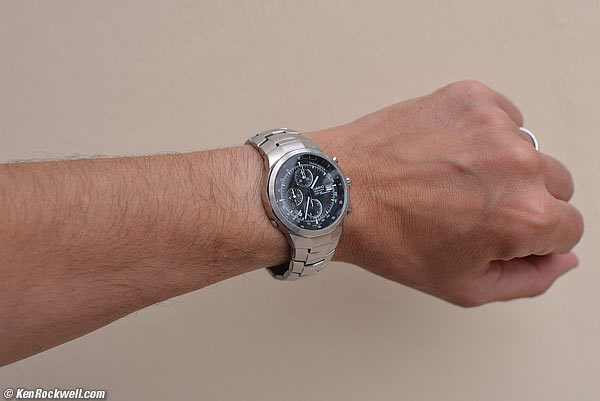
At closest focus distance (0.5 meters) on FX or 35mm, AI version. (Shot on DX, the crop factor will make it seem 50% bigger).
Macro isn't very close; if you want close at 55mm, use the 55mm f/2.8 macro or any other Nikon macro lens.
Fabric. D800E, f/8 at 1/250 hand-held at Auto ISO 100. Original 36MP file.
Like most fast 50mm lenses, curvature of field at close distances limits edge sharpness. Duh, if you want super-sharp shots of flat things with a normal lens, use the 55mm f/2.8 or any of the other macro lenses.
Mechanics performance top
Nikon 55mm f/1.2. enlarge.
Like all Nikkor manual focus AI-s lenses, the Nikon NIKKOR 55mm f/1.2 is built to the highest mechanical standards of any lens ever made.
Barrel Exterior
Anodized and enameled aluminum.
Filter Threads
Anodized aluminum.
Focus Ring
Anodized and enameled aluminum.
Rubber covered from 1974.
Focus Helicoids
Brass.
Depth-of-Field Scale
Engraved into barrel and filled with different colors of paint.
Internals
All metal.
Aperture Ring
Cast aluminum, anodized and enameled.
Engraved markings filled with different colors of paint coded to the depth-of-field scale.
Automatic Aperture-Coupling Prong (if present, from 1977)
Solid chromed, machined brass.
Mount
Dull-chromed brass.
Markings
Engraved into the metal and filled with paint.
Identity and Serial Number
On the front of the lens, engraved into the metal and filled with paint.
Moisture Seal at Mount
No.
Noises When Shaken
Mild clicking from the diaphragm blades and actuation system.
Made in
Japan.
Sharpness performance top
Warning 1: Image sharpness depends more on you than your lens.
Warning 2: Lens sharpness doesn't mean much to good photographers.
With those caveats, the 55mm f/1.2 is always sharp, however at f/1.2 it's highly unlikely you'll have anything in the perfect focus required for sharpness unless you use magnified Live View. If you do, f/1.2 looks soft because of the low contrast and nonexistent depth of field, however the resolving power is there.
Palm. D800E, f/8 at 1/60 hand-held at Auto ISO 110. Original 36MP file.
In this sample, know that even at f/8, very little is in perfect focus.
At f/1.2
If you get perfect focus, the center is surprisingly sharp, while the sides get softer.
Coma will kill you if you have bright points of light in the corners, otherwise, no problem other than softness.
At f/1.4
f/1,4 is almost the same as f/1.2.
The only difference is if you're splitting hairs in the lab or on a D800E, in which case the center has slightly higher contrast than at f/1.2.
At f/2
Contrast is much, much higher. The center and most of the image is very sharp and contrasty. The sides are softer.
At f/2.8
The center is a little better, and was already excellent at f/2.
The sides are much better at f/2.8 than at f/2.
At f/4
The center and sides are all very sharp.
If you're looking way too hard with a 36MP D800E, the last few millimeters of the corners are still a little bit softer.
At f/5.6
f/4 is pretty much perfect, and so is f/5.6.
If you're looking way too hard with a 36MP D800E, the last few millimeters of the corners are better than they were at f/4.
At f/8
The center is very slightly softer due to Diffraction
If you're looking way too hard with a 36MP D800E, the last few millimeters of the corners are better than they were at f/5.6, which is very good.
At f/8 and smaller
Diffraction limits performance at smaller apertures.
Spherochromatism performance top
As expected, the Nikon 55mm f/1.2 has strong spherochromatism, meaning that out-of-focus highlights can sometimes take on a little bit of green or magenta color fringes.
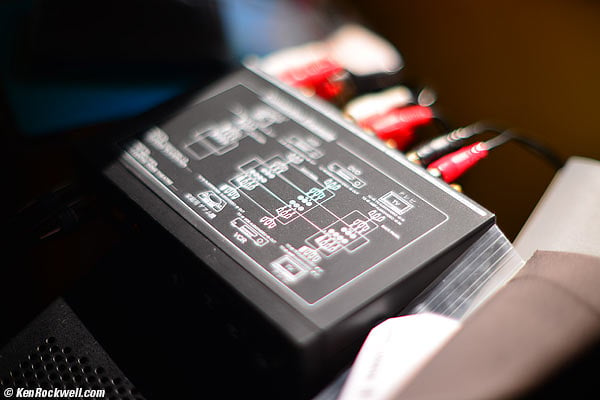
Full FX image at f/1.2. Note color shifts on white lines.
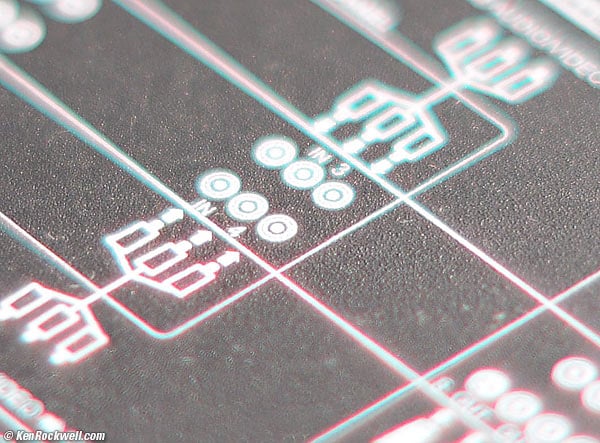
Crop from above. Note green fringes on background highlights and magenta fringes on closer highlights.
Don't worry about this; you won't see it unless you go out of your way to excite it as I did here. You will see it as slight colored fringes on out-of-focus objects.
Sunstars performance top
With its straight 7-bladed diaphragm, the 55mm f/1.2 makes great Nikon-standard 14 -pointed sunstars on bright points of light, even at moderate apertures. See the corner crops above at Coma for samples.
Compared top
Intro Specifications Performance Compared Recommendations
Nikon 50mm f/1.2 AI-s and 55mm f/1.2 AI. enlarge.
Nikon 50mm f/1.4 AI, 55mm f/1.2 AI, 50mm f/1.2 AI-s and 58mm Noct. (The Nikon 50mm f/1.4 AI has the same optics as the 50mm f/1.4 AI-s, 50mm f/1.4 AF and 50mm f/1.4 AF-D.) enlarge.
I compared this 55mm f/1.2 directly to the Nikon 50mm f/1.4 AI, 50mm f/1.2 AI-s and 58mm Noct-NIKKOR at the test range with the D800E.
Which is best depends on what aperture you're using, and your subject.
If your subject is points of light at large apertures, like Christmas lights or cityscapes at night, the clear leader by far is the 58mm Noct-NIKKOR, which is expressly designed to keep these points of light as points at f/1.2. Otherwise, the 58mm Noct is softer everywhere except in the center. That's the price you pay for a specialized lens without coma.
If you shoot mostly at medium and small apertures like f/5.6 and smaller, the Nikon 50mm f/1.4 AI (and its optically identical 50mm f/1.4 AI-s, 50mm f/1.4 AF and 50mm f/1.4 AF-D brethren) are sharpest.
I didn't compare the Chinese-made Nikon 50mm f/1,4 G AF-S here. It's optics are great and possibly better than all of these, except for coma compared to the Noct, but as an AF-G lens, won't work on manual-focus cameras for which these lenses are intended. If you're shooting an AF or digital camera, use an AF lens for sanity's sake.
Shot on the test range at 200 meters with the Nikon D800E:
Perfect focus is absolutely critical for meaningful comparisons. The only way to get this reliably is to use Live View at the largest magnification, as I did for this test.
At f/1.2
They are all about as sharp in the center, astoundingly so, with the 50mm f/1.2 AI-s maybe slightly best. This is what happens in 2012 when we finally can get perfect focus. When these lenses were introduced, it was almost impossible to get perfect focus with the focus aids of manual cameras and their mechanical mirror calibrations to get the on-screen image to match on-film, especially as the film was never flat.
On the sides, the 58mm Noct is clearly the worst. The 50mm f/1.2 AI-s is the best, and this 55mm f/1.2 is almost as good.
The 50mm f/1.4 AI doesn't go to f/1.2. The 50mm f/1.4 AI at f/1.4 is a bit contrastier (sharper looking) than the other lenses are at f/1.2.
At f/1.4
In the center, the two 50mm lenses are sharpest. The 55mm and 58mm are very slightly less sharp. This is insignificant and would be invisible under anything other than a direct comparison.
On the far sides, the 50mm f/1.2 AI-s is best, with the 50mm f/1.4 AI close. The 55mm is worse, and the 58mm Noct is by far the worst.
At f/2
They're all the same in the center.
On the sides, the 50mm f/1.2 AI-s is best, and the 50mm f/1.4 AI is almost as good. The 55mm f/1.2 is worse, and the 58mm Noct is worst.
At f/2.8
They're all the same in the center.
On the sides, the 50mm f/1.2 AI-s is best, and the 50mm f/1.4 AI is almost as good. The 55mm f/1.2 is worse, and the 58mm Noct is worst.
At f/4
They're all the same throughout about the central half of the image.
On the far sides, the two 50mm lenses are as sharp as each other. This 55mm is almost as good, and the 58mm Noct is dead last as usual.
At f/5.6
They're all the same in the center and throughout most of the image.
On the far sides, the two 50mm lenses and this 55mm are as sharp as each other. The 58mm Noct is still softer.
At f/8
They're all the same in the center and throughout most of the image.
On the far sides, the two 50mm lenses are as sharp as each other. This 55mm and the 58mm Noct aren't quite as good, but it's close.
See also my sharpness comparison of other ultraspeed normal lenses.
Recommendations top
Intro Specifications Performance Compared Recommendations
The Nikon 55mm f/1.2 is a manual-focus only lens. If you're using an autofocus or digital SLR, an AF lens will make life much easier.
If your subject is moving, you can't focus precisely enough to get all the performance at f/1.2 of which this lens is capable, and if you're on a tripod, you can stop down, so again, you don't need this special-purpose lens.
if you want the sharpest lens for general photography, the Nikon 55mm f/2.8 AI-s is the sharpest lens ever made by Nikon, as are all the other newer Nikon autofocus macro (micro) lenses.
Your viewfinder won't be any brighter with this f/1.2 lens than an f/1.8 lens. Why? Because the super-bright screens used on cameras made since about 1979 only "focus" on the f/2.8 central core of the lens. The only cameras on which this ultraspeed lens will give a brighter image than other lenses is on very old cameras like the original FE and Nikon F and F2S with traditional "dark" real ground-glass screens.
If you want the most out-of-focus backgrounds, any longer but slower lens like the inexpensive 135mm f/2.8 will do a better job. Why? Because focal length has a far stronger effect on defocus than does aperture.
So why then this f/1.2 lens? This lens lives for people who need all the light-gathering ability they can get. This means people shooting 35mm, for which film above ASA 400 looks really bad, and for astronomers for whom this can save hours of time waiting around for exposures to complete.
For the people who need f/1.2, this is the least expensive way to get it from Nikon, and its performance at f/1.2 is remarkable about as good as the legendary 58mm f/1.2 Noct-NIKKOR's, and significantly better at smaller apertures.
The current 50mm f/1.2 AI-s is a little better and smaller, but if you're counting pennies, this is a marvelous lens.
Deployment top
I'd pitch the flat Nikon cap that came with this lens new, and get a new "pinch" type cap. I'm not kidding: the new fatter caps are much easier to use in the field.
I'd leave either a 52mm Nikon Clear (NC - UV) filter, or a 52mm Hoya Super HMC UV on the lens at all times. I would leave the hood at home.
If I was working in nasty, dirty areas, I'd forget the cap, and use an uncoated 52mm Tiffen UV filter instead. Uncoated filters are much easier to clean, but more prone to ghosting.
For color slides like Velvia 50, I use an old Nikon A2 or new 52mm Hoya HMC 81A outdoors.
For B&W film outdoors, I'd use an old Nikon Y48 or O56, or a new 52mm Hoya HMC K2 Yellow or 52mm Hoya HMC Orange.
Help me help you top
I support my growing family through this website, as crazy as it might seem.
The biggest help is when you use any of these links when you get anything, regardless of the country in which you live. It costs you nothing, and is this site's, and thus my family's, biggest source of support. These places have the best prices and service, which is why I've used them since before this website existed. I recommend them all personally.
If you find this page as helpful as a book you might have had to buy or a workshop you may have had to take, feel free to help me continue helping everyone.
If you've gotten your gear through one of my links or helped otherwise, you're family. It's great people like you who allow me to keep adding to this site full-time. Thanks!
If you haven't helped yet, please do, and consider helping me with a gift of $5.00.
As this page is copyrighted and formally registered, it is unlawful to make copies, especially in the form of printouts for personal use. If you wish to make a printout for personal use, you are granted one-time permission only if you PayPal me $5.00 per printout or part thereof. Thank you!
Thanks for reading!
Mr. & Mrs. Ken Rockwell, Ryan and Katie.
Home Donate New Search Gallery Reviews How-To Books Links Workshops About Contact





